What are the types of motorhomes? The ultimate motorhome types list
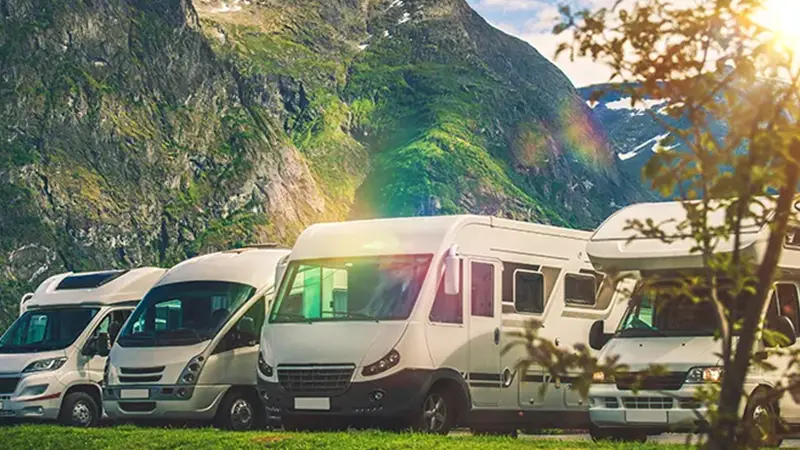
If one wants to acquire a motorhome, it is important to know what different types of motorhomes there are. Many beginners ask themselves, "Which type of motorhome suits me best?"
Here we present all the types of motorhomes. Learn what features and advantages each type has and which one suits you best.
There are the following types of motorhomes:
- Camping bus
- Cabins
- Rooftop tents
- Panel van camper
- Alcove motorhome
- Semi-integrated motorhomes
- Fully integrated motorhomes
- Liner
- Expedition vehicles
Discover the different types of motorhomes - Which one suits you best?
Especially beginners are often faced with the question, which motorhome is the right one.
A camper van, a partially integrated motorhome, a fully integrated motorhome or rather the royal class, a liner. Here you can learn more about the different types of motorhomes.
Motorhome type: camping bus
The Camping Bus is very compact and, in addition to its function as a camping vehicle, is also very suitable for everyday use.

The installed camping equipment often offers multifunctional elements to provide sleeping, sitting and cooking facilities in the very confined space.
A wet cell is usually not available. Standing in the vehicle is not possible without a pop-up roof.
With a camper bus most people probably associate a VW bus, affectionately called Bulli. This is because the Volkswagen T1 model started the mobile camper era in Germany.
Today, camper buses are based on different types of vehicles, however, Volkswagen still has the largest market share.
This type of motorhome is popular mainly because these types of vehicles are very suitable for everyday use. Due to the significantly smaller dimensions compared to motorhomes of other genres, camper buses can replace the conventional passenger car.
In this video you can get a first impression of the Camping Bus.
Many camping buses are often just under 5 meters long and under 2 meters wide. The interior is usually multifunctional and often offers sleeping accommodations for up to 5 people.
A multifunctional kitchen with hob, fridge and sink offers the possibility to prepare meals for the whole family.
Most often, a camper has rotating front seats. It can dine up to 5 people in a quickly assembled dinette.
Thanks to the variable components, there is sufficient storage space available to also transport a bicycle, for example.
Advantages and disadvantages of a camping bus
Advantages
- Small and agile
- Suitability for everyday use
- No additional vehicle is needed
Disadvantages
- Limited storage space
- Low standing height (standing only possible with pop-up roof)
- Little habitat when the weather is bad
For whom is a camping bus suitable?
A camping bus is suitable for individuals, couples or small families who like to travel and prefer a compact and maneuverable motorhome. They are usually cheaper than other types of motorhomes and are particularly suitable for short trips and city breaks.
Motorhome type camper cabins
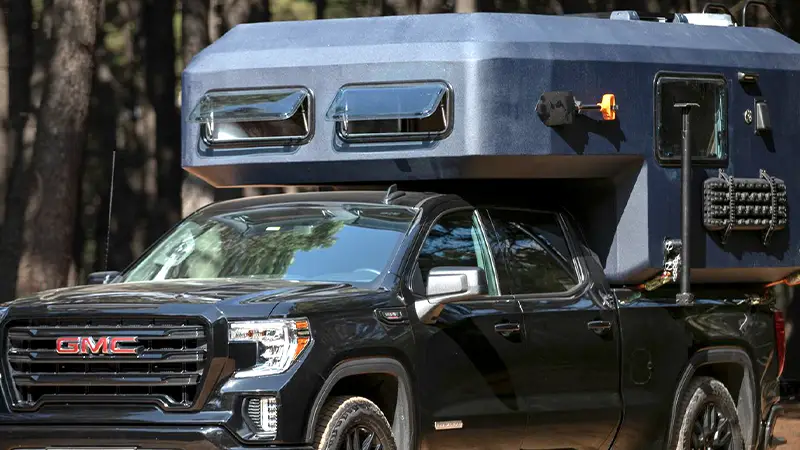
Living cabins are mounted on pickup vehicles such as a Toyota Hilux or a Ford Maverick. The biggest advantage that living cabins offer is that the base vehicle is completely suitable for everyday use after the living cabin has been removed. There is no need for a second vehicle, because for traveling, the living cabin is simply put back on the pickup vehicle.
A mobile home is not subject to registration and does not require TÜV approval or vehicle tax. There is a diverse range of models for every application. Almost all pickup models are suitable for use as a pickup camper.
In this video you can get an impression of cabins.
Cabins are often equipped in the same way as a van camper. There is a sleeping place, a kitchen, a wet cell and a dinette. Certainly everything a little more compact than in a conventional motorhome, but for this a cabin offers the possibility to use the base vehicle in everyday life.
Advantages and disadvantages of cabins
Advantages
- Suitable for off-road
- Small and agile
- No second vehicle necessary
- Suitability for everyday use
Disadvantages
- No passage from the cab to the living area
- Little habitat when the weather is bad
- Limited storage space
For whom is a living cabin suitable?
A residential cabin is suitable for singles or couples. With more than two people it will be difficult with most models, because the space is not enough. If you already have a pickup truck anyway, then a living cabin can be the ideal solution. By putting the living cabin up and down, the base vehicle remains absolutely suitable for everyday use.
Motorhome type roof tents
Roof tents are not a camper in the classic sense, but it is still mobile living. Due to the recent huge price increases in the field of motorhomes, especially among younger camping fans, the roof tents are a cheap alternative to classic motorhome.
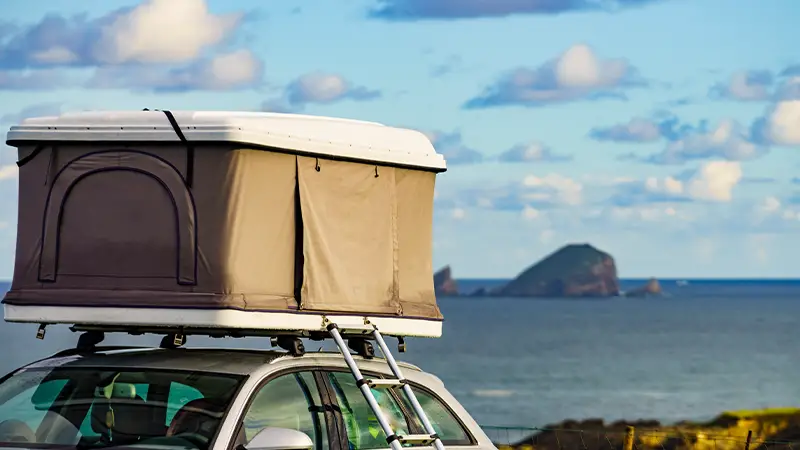
Roof tents can be mounted on almost any car. Of course, the maximum roof load must be considered, but in principle, the base vehicle can be changed at any time.
Mounting a roof tent is very simple. The vehicle must have a roof rack. Usually then only the roof tent is placed on the roof rack, fastened and after a few minutes it is ready for use.
In this video from ADAC 7 different roof tents are tested
Advantages and disadvantages of roof tents
Advantages
- Inexpensive
- Quickly mounted
- No second vehicle necessary
Disadvantages
- No wet room, no classic kitchenette
- Little habitat when the weather is bad
- Limited storage space
Who is a roof tent suitable for?
A roof tent is suitable for one to two people. This type is especially suitable for adventurers and outdoor lovers. They offer the possibility of sleeping under the open sky and are usually compact and easy to handle.
Motorhome type panel van
Box van motorhomes also known as camper vans are more compact and flexible than motorhomes.
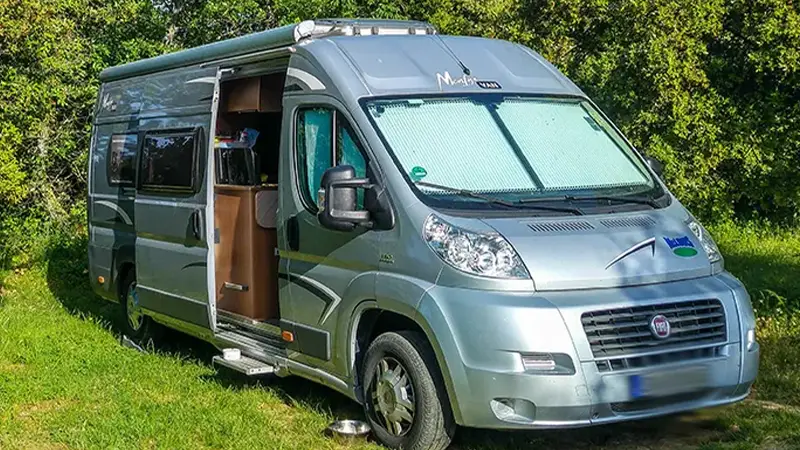
In just a few square meters, most models offer a large sleeping area, a toilet with shower, a kitchen and a dinette.
A panel van is usually suitable for two people. However, models with four to five sleeping berths are also offered.
The expanded box van has recently recorded the largest growth figures in the field of mobile homes. Certainly not without reason.
The panel van camper offers a complete living space with kitchen, wet cell with toilet, sleeping area and dinette. At the same time, however, the suitability for everyday use is maintained.
Mostly with a permissible total weight of only 3.5 tons, is sufficient for driving an extended van, the conventional passenger car driver's license.
Box vans are based on the van versions of various vehicle types. Probably the most common extended brand is the Fiat Ducato. But also Citroen Jumper, Peugot Boxer, Ford Transit or a Mercedes Sprinter are very popular as base vehicles for a panel van camper.
Popular is this motorhome variant mainly because without major conversion measures all areas can be used. These vehicles often offer standing heights up to 2 meters. Box vans can be operated self-sufficiently for at least a while. Fresh water tanks with about 100 liters, waste water tanks, solar energy, diesel heating, refrigerator with freezer compartment help to spend a few days even in the wild.
In this video you can get a first impression of a 599 cm panel van camper.
Depending on the base vehicle, a panel van with an external length of 5.41 meters to 6.36 meters, a width of about 2.05 meters, is still suitable for everyday use. Although the van is superior to the camper buses in terms of suitability for everyday use, but a van offers a complete apartment on wheels.
Depending on the floor plan, length and manufacturer of the extended panel van, this offers up to five sleeping places. As a rule, two sleeping berths are always accessible and the other sleeping berths must be built up in a few simple steps.
Kitchens in the van usually offer everything that is needed. A small sink, a gas hob with two to three flames, hot and cold running water, a refrigerator with freezer compartment and numerous drawers and compartments as storage space for kitchen utensils.
The rotating front seats allow up to 5 people to dine in the dinette. Thus, the passenger compartment is integrated into the living space. On many models, the dinette table can be enlarged by a swiveling extension.
The wet cell provides ample space for a toilet and shower. Depending on the model and manufacturer, there are various solutions to accommodate the wet cell space-saving in the van.
Depending on the model and manufacturer, the storage space in the rear garage can vary, but in most models the rear garage of a converted van offers enough space to store camping furniture and accessories. Some models can even transport bicycles. If the rear garage does not offer enough storage space for bicycles can also be optionally mounted a bike rack on the rear doors.
Advantages and disadvantages of box van motorhomes
Advantages
- Sufficient headroom available
- Mostly all areas usable without conversions
- Shower and WC usually available
- Sufficient storage space
Disadvantages
- Living space limited
- Only conditionally suitable for everyday use
- Limited parking in cities and on narrow streets.
For whom is a panel van camper suitable?
The panel van camper is basically more suitable for couples or solo travelers. Although there are models that offer up to five berths, the permissible total weight is limited to 3,500 kg for most models. Traveling with more than two people is usually only possible if the van is loaded up. A load increase means increasing the permissible gross weight by means of technical modifications. However, these modifications turn the panel van into a truck, for which a special driver's license may be required. In addition, there are restrictions to be taken into account in road traffic.
Motorhome type alcove motorhome
The alcove motorhome owes its name to the structure above the driver's cabin.
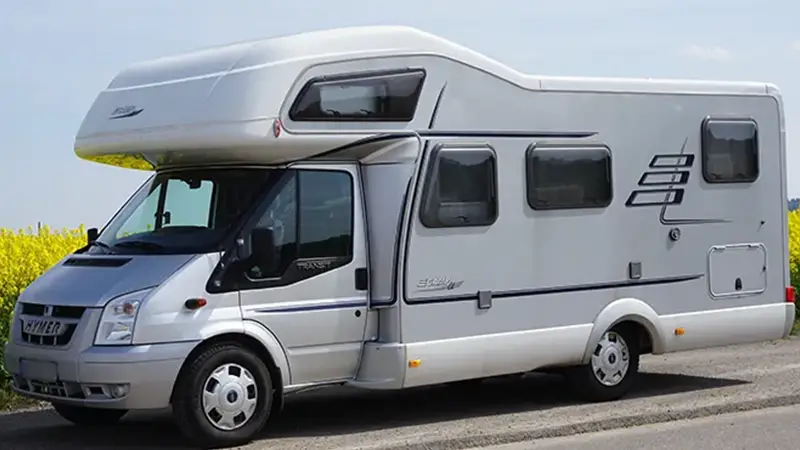
This body, without taking away space in the living area, provides additional sleeping space. Often this type of vehicle is chosen by families with children.
Accordingly, the alcove motorhome offers 4-6 berths, a spacious kitchen, a separate bathroom, as well as enough seats and ample storage space.
With the design of the alcove motorhome everyone immediately associates a motorhome. The characteristic superstructure above the driver's cab is the characteristic for the popularity of the alcove motorhome.
The alcove body is popular because it contains an additional sleeping space, which is often used by children. The additional sleeping space does not take up any space in the living area. For children, this area offers the possibility to retreat during the day to play.
The alcove is therefore a typical family motorhome. In addition to the alcove sleeping berths, there is usually another double bed in the living area and also options for setting up additional sleeping berths.
In this video we show you an alcove motorhome
The feeling of space is generous and of course you will find everything you need in the alcove.
In addition to the described sleeping places, a kitchen, a toilet with shower and a dining area. Very much storage space and a large rear garage offer enough space for everything needed on vacation.
The alcove motorhome can be between 6.50 meters and over 8.00 meters long, depending on the manufacturer and model. Nevertheless, many models do not exceed the permissible total mass of 3.5 tons, so that the vehicle may be driven with a conventional passenger car license. However, in the case of several people, the total weight should be checked before starting the journey.
The alcove sleeping area is usually accessible via a ladder. For children, this "sleeping cave" is a little paradise. For adults, however, reaching the sleeping area may be a bit tedious.
In the rear area of the alcove motorhomes there is usually a fixed sleeping place in the form of a double bed or two single beds. In addition, there are often numerous storage compartments or a closet in this area.
The kitchen is compact, but has everything you need. A small sink, a gas hob with two to three flames, hot and cold running water, a refrigerator with freezer compartment and numerous drawers and compartments for storage of kitchen utensils. In some models you can also find an oven.
The rotating front seats integrate the cab into the living area, providing ample seating in the dinette.
A complete bathroom with shower provides enough space and opportunity for personal hygiene. Depending on the model and manufacturer, the shower and toilet can also be spatially separated.
Advantages and disadvantages of alcove motorhomes
Advantages
- Große Modellauswahl
- More sleeping places due to the extra space in the alcove
- Complete package of vehicle, sleeping place, living room, kitchen and bathroom
- Absolutely suitable for families
Disadvantages
- Payload can become a problem
- Driving noise can be loud
- Larger dimensions
- Note the height of the vehicle for tunnels and bridges
For whom is an alcove motorhome suitable?
An alcove motorhome is suitable for families with children. The alcove body usually holds one to two additional sleeping berths, which are specially designed for children. Due to the lightweight construction, most alcove models also have sufficient payload capacity.
Motorhome type semi-integrated motorhomes
The partially integrated owes its name to the fact that the original cab of the car is retained, but the living area is completely rebuilt.
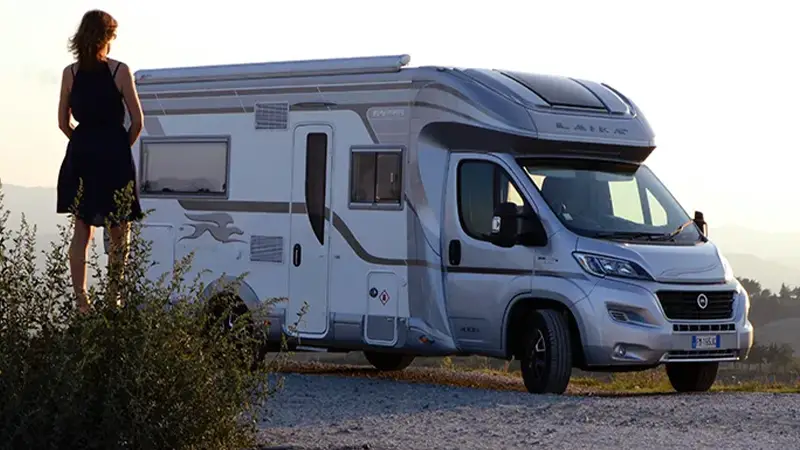
It is suitable for two to four people and accordingly offers up to four sleeping berths, spacious kitchen, a separate bathroom, as well as sufficient seating and ample storage space.
A partially integrated motorhome is characterized by the fact that the passenger compartment of the original base vehicle is retained, but the entire body of the van is replaced by lightweight construction.
This is also the reason that many semi-integrated models are located below the 3.5 ton limit. For people who have acquired your car driving license after 1999, it applies that only vehicles up to 3.5 tons may be led.
A partially integrated motorhome is more suitable for two people, but is quite suitable for families, depending on the model and manufacturer.
The vehicle offers everything that is needed, usually in the rear of the vehicle is the sleeping area. Either a double bed, or two single beds. In the middle area is the wet cell with toilet and shower and the kitchen block.
The passenger area integrates with the living area by turning the seats towards the living area.
This type of vehicle offers ample storage space and a spacious rear garage.
Here you can watch a video of a semi-integrated motorhome
A semi-integrated motorhome can be between 6.50 meters and up to 8.00 meters and more long, depending on the manufacturer and model. With many models, nevertheless, the permissible total mass of 3.5 tons is not exceeded, so that the vehicle may be led with a conventional passenger car driver's license. However, in the case of several people, the total weight should be checked before starting the journey.
In the rear of the semi-integrated motorhome is often fixed sleeping space in the form of a double bed or two individual beds. In addition, there are often numerous storage compartments in this area.
The compact kitchenette, offers a small sink, a gas hob with two to three flames, hot and cold running water, a refrigerator with freezer compartment and numerous drawers and compartments for storage space for kitchen utensils.
The seats of the driver's cabin usually rotate, thus integrating with the living space. The number of seats in the dinette can thus be expanded.
The wet cell usually consists of a toilet and shower. Depending on the model and manufacturer, the shower and WC can also be spatially separated.
Advantages and disadvantages of semi-integrated motorhomes
Advantages
- Large model selection
- Complete package of vehicle, sleeping place, living room, kitchen and bathroom
- Suitable for families, but more suitable for 2 people
Disadvantages
- Payload can become a problem
- Driving noise can be loud
- Larger dimensions
For whom is a semi-integrated motorhome suitable?
A semi-integrated motorhome is suitable for two people. Depending on how much payload a model offers, up to four people can also travel in the semi-integrated motorhome. However, since most models are designed for a maximum total weight of 3,500 kg, overloading can occur.
Motorhome type fully integrated motorhomes
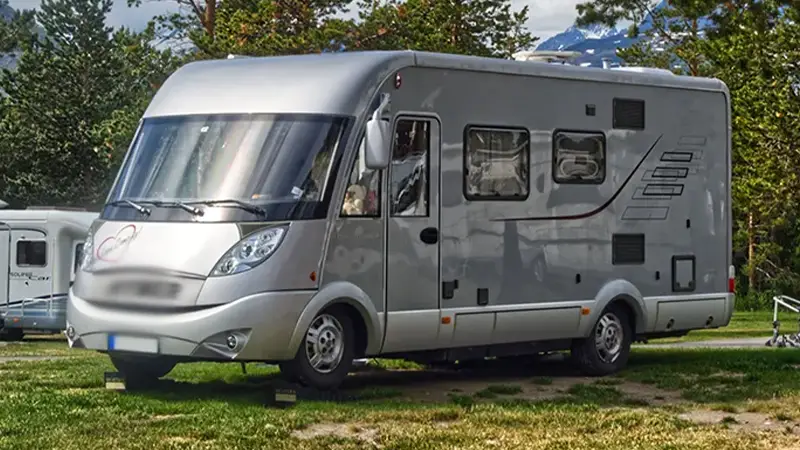
In a fully integrated motorhome, the original cab is not retained. It is individually designed for the motorhome and merges seamlessly into the living area.
Fully integrated motorhomes are designed as recreational vehicles, so the design uses only the chassis, transmission and engine of commercial vehicles.
The special thing about fully integrated motorhomes is the large amount of space they offer.
A fully integrated motorhome is characterized by the fact that the passenger cell of the original base vehicle is integrated into the entire body of the van. This gives the vehicle the appearance of being cast from a single mold.
In these types of vehicles, the focus is on convenience, luxury and functionality.
A fully integrated motorhome is like a hotel room when used by two people, but depending on the model and manufacturer it is very suitable for families. Many models offer additional sleeping space.
The vehicle offers everything that is needed, usually in the rear of the vehicle is the sleeping area. Either a double bed, or two single beds. In the middle area is the wet cell with toilet and shower and the kitchen block.
The passenger compartment integrates with the living area by turning the seats to face the living area.
This type of vehicle offers ample storage space and a spacious rear garage.
A fully integrated motorhome can be between 7.00 meters and up to 9.00 meters or more in length, depending on the manufacturer and model. As a rule, the permissible total weight of 3.5 tons is also exceeded, so that this vehicle category is to be considered as a truck in terms of road traffic.
Watch this video to get an impression of an integrated motorhome
In the rear of the fully integrated motorhome is in most cases a fixed sleeping place in the form of a double bed or two single beds. In addition, this area is often also numerous storage compartments.
The kitchenette, offers a sink, a gas hob usually with two to three flames, hot and cold running water, a refrigerator with freezer compartment and numerous drawers and compartments as storage space for kitchen utensils.
The seats in the driver's cabin thereby integrated into the living space by their swivel function and extend the seating in the dinette.
The wet room usually consists of a toilet and shower. Depending on the model and manufacturer, the shower and WC can also be physically separated.
A view of the vehicle from the passenger compartment conveys the feeling of space that such a vehicle brings.
Advantages and disadvantages of fully integrated motorhomes
Advantages
- Large model selection
- Complete package of vehicle, sleeping place, living room, kitchen and bathroom
- Suitable for families, but more suitable for 2 people
- Good sense of space
Disadvantages
- Clarity when driving
- Mostly over 3.5 tons - observe driver's license
- Requires more space for parking and storage
For whom is a fully integrated motorhome suitable?
Fully integrated motorhomes are suitable for two to five people, depending on the model. However, most fully integrated models have a permissible total weight of over 3.5 tons. Therefore, care must be taken whether a corresponding driver's license is available.
Motorhome type liner
Similar to the luxury liners of the major shipping companies, liners belong to the royal class when it comes to motorhomes.
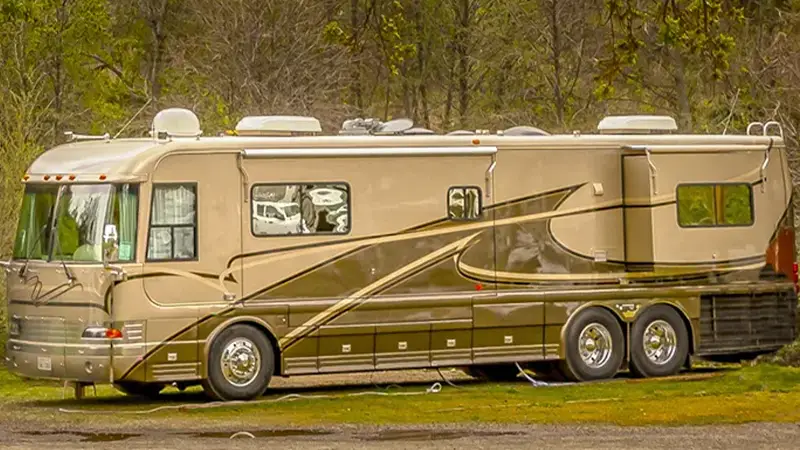
Liners are luxury apartments on wheels. In these vehicles, the equipment is limited only by the buyer's budget.
The exclusive comfort models offer a unique experience of space and luxury. From the whirlpool to the sauna, to the garage for a car.
Liners belong to the upper class of motorhomes. Price-wise these vehicles are to be compared with a single-family house. For this, however, these motorhome types also leave hardly any wishes unfulfilled.
In the quality and the equipment the borders are set quasi only by the own budget.
In a Liner one does not speak of wet cell, but of the bathroom. One does not speak of the sleeping area, but of the bedroom.
They are mobile luxury apartments, which often even offer underground parking for a car.
A liner motorhome can be between up to 12.00 meters and more long, depending on the manufacturer and model. Many models exceed the maximum permissible mass of 7.5 tons, so that a truck driver's license is required to drive the vehicle.
In this video we show you a liner motorhome
In the rear of the Liner motorhomes is usually a fixed sleeping place in the form of a double bed or two single beds. In addition, this area is often also numerous storage compartments and a closet.
The kitchen leaves little to be desired and offers, in addition to the sink, a hob, hot and cold running water, a refrigerator with freezer compartment and numerous drawers and compartments as storage space for kitchen utensils. It is not uncommon to find an oven and dishwasher.
The seats of the driver's cabin are often rotatable and thus integrated into the living space. The number of seats in the dinette can thus be expanded.
In many Liner motorhomes, you'll find a full bathroom with a spacious shower, toilet, large sink, and plenty of storage space.
The feeling of space in a Liner motorhome is overwhelming. Depending on the model and manufacturer, slide-outs are often available to expand the already generous living space.
Frequently, Liner motorhomes also offer the option of an additional car garage to be mobile at your destination.
Advantages and disadvantages of a liner motorhome
Advantages
- Very comfortable
- Plenty of storage space
- Suitable for families
Disadvantages
- Very heavy, some even over 7.5 tons
- Very expensive
- Uncluttered dimensions
For whom is a liner motorhome suitable?
A liner motorhome is suitable for people who do not want to do without anything during your camping vacation. The mostly very luxuriously equipped motorhomes are usually only with a truck driving license to drive. Many models even offer the possibility to transport a car in the motorhome. A liner quickly costs several 100,000, - up to several million euros.
Motorhome type expedition vehicles
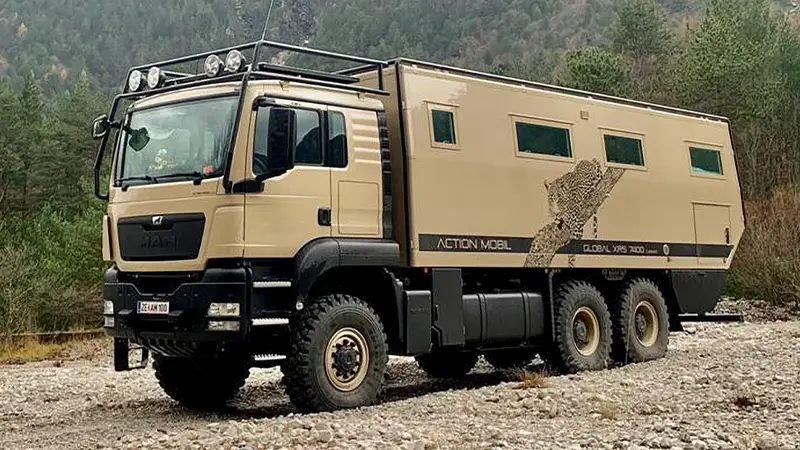
Expedition vehicles offer the opportunity to travel off paved roads, areas that are not accessible with conventional motor homes. Often expedition vehicles are built on a truck base or a Unimog. There is a lot of emphasis on self-sufficiency, because usually with such vehicles rarely or never campsites are approached.
Expedition vehicles are usually used to travel to places that are far from any civilization. Therefore, these vehicles often have very large water and fuel tanks.
.The use of this type of motorhome is about independence, freedom and a sense of adventure.
Watch this video to get a first impression
Advantages and disadvantages of an expedition vehicle
Advantages
- Comfortable
- Self-sufficient
- Suitable for families
- Off road capable
Disadvantages
- Very heavy, some even over 7.5 tons
- For many models truck driving license required
- Very expensive
For whom is an expedition vehicle suitable?
An expedition vehicle is suitable for adventurers and outdoor lovers who travel away from the usual camping vacations for longer periods in remote regions and countries and need a robust and off-road vehicle. It is particularly suitable for couples or families who have the necessary budget, as it is an expensive class of vehicle and is only worthwhile if you have the opportunity to travel for a long period of time.
Questions and answers
The difference between a partially integrated and a fully integrated motorhome is that the cab of the fully integrated motorhome is fully integrated into the living space, while the partially integrated motorhome retains the cab of the base vehicle and only the body of the motorhome is replaced.
The difference between a motorhome and a camper is virtually non-existent. They are just different terms for the same thing. The term camper was adopted from the English language and means nothing other than motorhome.
Almost any motorhome is suitable for two people. Starting from the box van to the liner. It is rather a question of the requirements and the budget. If you prefer it compact, a van is the first choice. If you want the absolute luxury, then there are also numerous liner motorhomes that are suitable for two people.
Share article

When is the cheapest time to buy a mobile home?
When is the best time to buy an RV - A good time to look for deals is during the winter months from November to February
